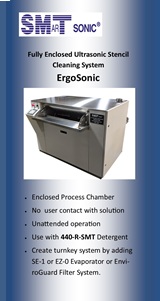|

|
|
| Ask the Experts | |||||||
|
|||||||
|
April 21, 2008 - Updated April 21, 2008 - Originally Posted Eutectic reflow for Pb-free BGAsCan I reflow Pb-free BGAs through an eutectic reflow process? S. Y. |
|||||||
| Expert Panel Responses | |||||||
|
No, because the reflow temperatures in the eutectic process will not be hot enough to melt the lead free solder balls on the BGA.
Regional Sales Manager OK International Inc. Ed Zamborsky is a Regional Sales & Technical Support Manager for Thermaltronics, located in New York. His position requires frequent customer visits throughout North America and the Caribbean and his position encompasses not only sales but the role of trainer and master applications engineer for all of Thermaltronics products. His expertise includes such specialties as hand soldering, convection and conduction reflow techniques, array rework, fluid dispensing equipment, and fume extraction. Ed has authored many articles and has presented many papers on topics such as; Low Volume SMT Assembly, Solder Fume Extraction, SMT Rework, BGA Rework, Lead-Free Hand Soldering, High Thermal Demand Hand Soldering, Lead Free Visual Inspection and Lead Free Array Rework.
Yes you can. The most important aspect of this reflow is the melting of the Pb-free solder balls of the BGA so that there will be adequate mixing of the molten solder from the solder ball and the solder paste. The reflow temperature and time above liquidus are critical, because of the SAC bumps on the BGA. A reflow temperature of around 220-225 degree C with an extended TAL (around 75 seconds) would be helpful in melting the balls, providing sufficient time for the lead from the solder paste to mix within the bulk, and the solder to wet the PCB pads. Depending on the finish on the PCB pad, the extended TAL may form thicker intermetallic. The user needs to be aware of this.
President inspīre solutions LLC Bjorn Dahle is the President of inspīre solutions LLC. He has 20 years experience in the electronic manufacturing industry with various manufacturing equipment companies covering pick & place, screen printers and thermal process management.
|
|||||||
| Submit A Comment | |||||||
|
Comments are reviewed prior to posting. You must include your full name to have your comments posted. We will not post your email address. |
|
Free Newsletter Subscription
Circuitnet is built for professionals who bear the responsibility of looking ahead, imagining the future, and preparing for it. Insert Your Email Address |
|

|




